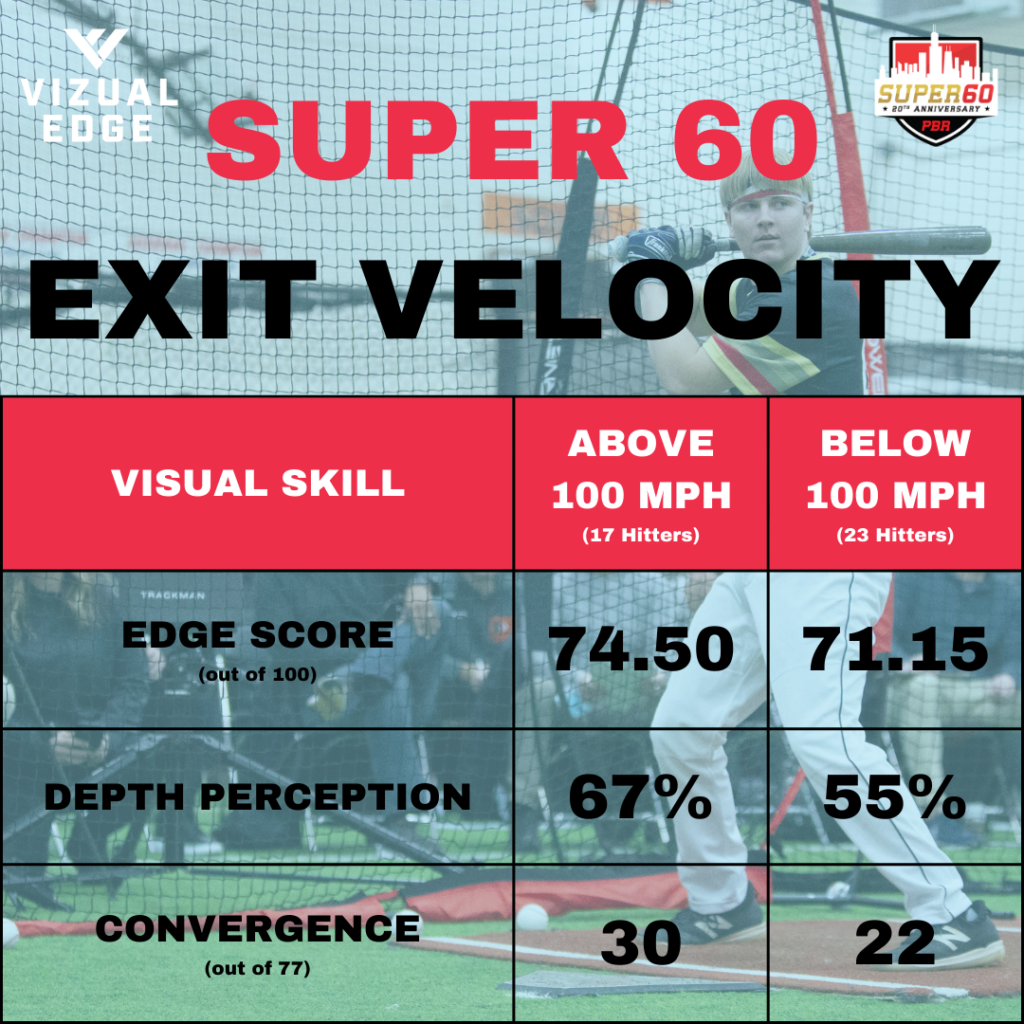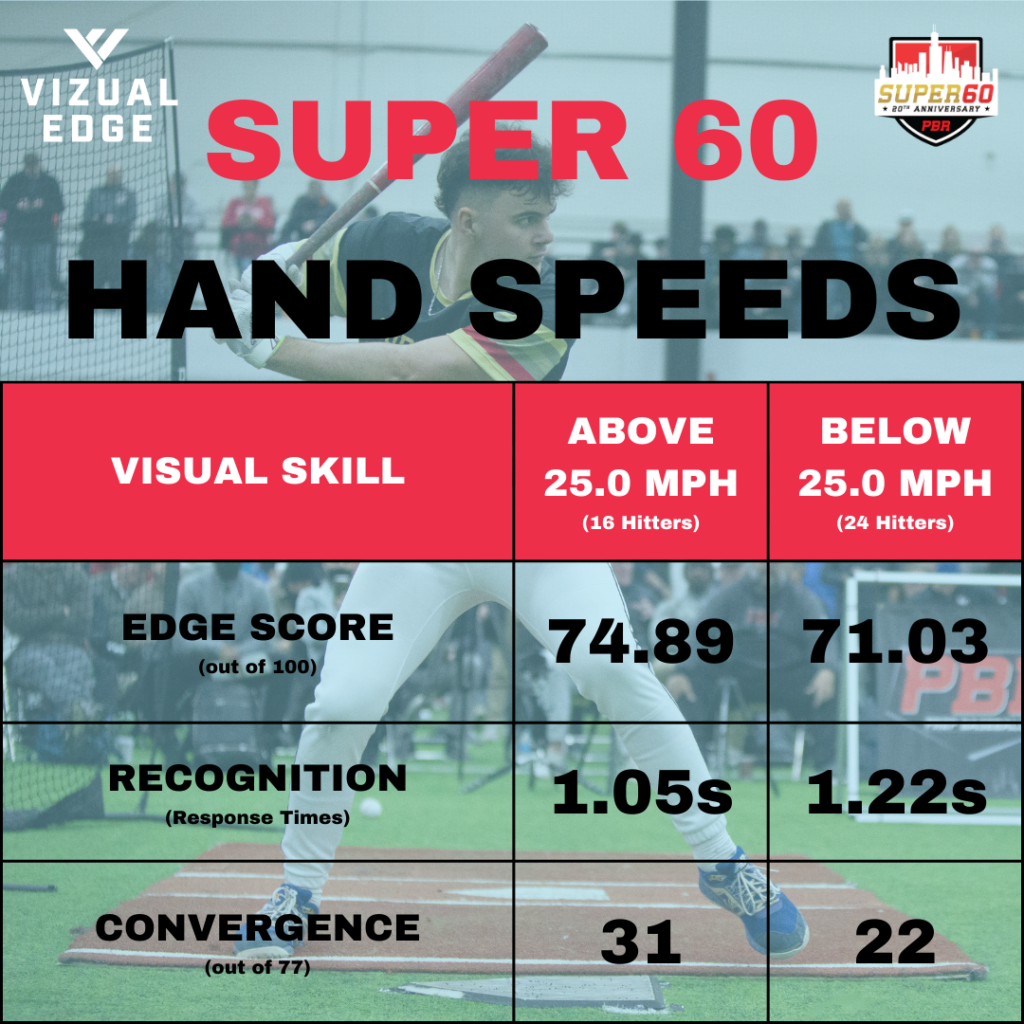2022 marked the 20th anniversary of Prep Baseball Report's Super 60 Pro Showcase in which the top draft-eligible players put their skills on display in Chicago. Just as the previous two Super 60 events, Vizual Edge was in attendance as the Official Vision Evaluation and Training Technology of PBR, putting all position players through a visual skills baseline assessment. Vision plays a critical role in baseball, but there is much more than just 20/20. Over 80% of sensory information is visual, thus it is important to assess where an athlete's visual skills stand, which is done through the Vizual Edge online baseline test.

This is also the first Super 60 event where player Edge Scores were added to PBR profiles, a recent update that will be the standard moving forward at nearly all PBR state events. Players have an opportunity to not only improve their Vizual Edge scores, which are metrics used by MLB teams and scouts, but also improve their performance on the field through discounted, at-home visual performance training. Every year, numerous MLB teams have potential draft picks complete the Vizual Edge test to gain insight into a player's visual processing system, and many Super 60 players should expect to be asked to take this test again in the coming months. Research has shown that better players tend to have better visual skills, which is why it is no surprise that players who reach the MLB have better visual skills and Vizual Edge scores than their counterparts.
As we dive deeper into the Vizual Edge metrics, we take a look at the top 5 position-players in each of the core visual skill categories and where each measurement impacts a player’s on-field performance. We also take a look at the visual skill differences in Exit Velocity and Hand Speed metrics provided by Trackman and Blast Motion, respectively.
| Rank | Name | Edge Score | State | School | Position |
| 1 | Zander Buchan | 85.87 | SC | AC Flora | C |
| 2 | Luke Adams | 84.10 | IL | Hinsdale Central | 3B |
| 3 | Dylan Carey | 82.42 | CO | Ponderosa | SS |
| 4 | Travis Sanders | 80.32 | TX | Copperas Cove | SS |
| 5 | Ethan Frey | 80.16 | LA | Rosepine | C |
The Edge Score is a comprehensive score out of 100 that takes the core-six visual skills into account, providing athletes, parents, coaches and scouts with a benchmark number for assessing an athlete’s overall visual ability. In general the higher the Edge Score, the higher chance of athletic success. Think of the Edge Score as the 'Sixth Metric' in the standard Five-Tools that make up a ball player.
The average top Edge Score for the 2021 MLB Draft Class was 80.0 (72% of hitters drafted in 2021 completed at least one Vizual Edge test). MLB players we've worked typically show stronger scores, with elite hitters scoring consistently above 85.0 on their Edge Score.
| Rank | Name | Convergence | State | School | Position |
| 1 | Zander Buchan | 67 | SC | AC Flora | C |
| 2 | Dylan Carey | 65 | CO | Ponderosa | SS |
| 3 | Luke Adams | 64 | IL | Hinsdale Central | 3B |
| 4 | Mitchell Voit | 64 | WI | Whitefish Bay | 3B |
| 5 | Dylan Dreiling | 53 | KS | Hays | OF |
Arguably the most important visual skill in baseball, Convergence relates to a player's ability to focus on a pitch as it approaches the final 15-20 feet to the plate. Many top hitters in the MLB have elite Convergence scores, another attribute that helps separate them from average hitters.
Convergence has also been a skill that is linked to exit velocity. The maximum Convergence score on the assessment is 77, and Super 60 position players whose max EV was at/above 100 MPH had Convergence scores 8 points higher than those below that mark.
| Rank | Name | Divergence | State | School | Position |
| 1 | Travis Sanders | 50 | TX | Copperas Cove | SS |
| 2 | Caden Powell | 43 | OK | Clinton | SS |
| 3 | Derek Smith | 37 | AZ | Horizon | C |
| 4 | Ethan Frey | 35 | LA | Rosepine | C |
| 5 | Kaden Carpenter | 34 | UT | American Fork | OF |
Similar to the scoring of Convergence, Divergence is also scored out of 77. Generally a more difficult skill compared to Convergence for baseball players, mainly due to the nature of the sport, Divergence focuses on the ability to locate objects from a distance.
Divergence plays a key role in early pitch and spin detection, as well as locating the ball out of the pitcher's hand.
Convergence and Divergence work in tandem to ensure a hitter can smoothly first identify/locate the ball from the pitcher's hand (Divergence) and be ready and track the ball all the way in as it approaches the plate (Convergence). The use of both of these skills simultaneously is called Alternating Flexibility, another key skill that is trainable with Vizual Edge.
| Rank | Name | Recognition | State | School | Position |
| 1 | Chris Maldonado | 0.50s (93%) | NJ | Seton Hall Prep | SS |
| 2 | Gregory Pace Jr | 0.58s (93%) | MI | Detroit Edison Academy | OF |
| 3 | Zander Buchan | 0.65s (85%) | SC | AC Flora | C |
| 4 | Derek Smith | 0.69s (89%) | AZ | Horizon | C |
| 5 | Easton Carmichael | 0.75s (77%) | TX | Prosper | C |
The Recognition test measures a players ability to view a sequence of three arrows that briefly flash across the screen and then quickly recite and enter the sequence they just viewed. This exercise is scored based on both response time (seconds) and accuracy (%).
At every level, especially with MLB hitters, players who have better Recognition scores generally have better plate discipline, as they are better at first accurately identifying a pitch type, but then also quicker to swing or lay off a pitch.
| Rank | Name | Tracking | State | School | Position |
| 1 | Chris Maldonado | 0.44s (89%) | NJ | Seton Hall Prep | SS |
| 2 | Payton Gubler | 0.45s (84%) | UT | Desert Hills | SS |
| 3 | Easton Carmichael | 0.45s (83%) | TX | Prosper | C |
| 4 | Brooks Brannon | 0.47s (88%) | NC | Randleman | C |
| 5 | Shai Robinson | 0.47s (88%) | IL | Homewood-Flossmoor | SS |
Tracking is another vital skill in baseball for hitting AND fielding. The Tracking exercise is scored based on response time and accuracy (just like the Recognition test) and tests a player's saccadic eye movements to locate a quick moving arrow and enter the correct response.
Players with better Tracking skills generally have a better ability to see a ball approach the plate, as well as react quick enough to identify the speed and distance of the ball as soon as it leaves an opponent's bat.
| Rank | Name | Depth | State | School | Position |
| 1 | Zander Buchan | 100% | SC | AC Flora | C |
| 2 | Brooks Brannon | 100% | NC | Randleman | C |
| 3 | Chris Maldonado | 100% | NJ | Seton Hall Prep | SS |
| 4 | Luke Adams | 88% | IL | Hinsdale Central | 3B |
| 5 | Gregory Pace Jr | 88% | MI | Detroit Edison Academy | OF |
Depth Perception measures a player's ability to identify differences with 3D objects. Depth Perception plays an important role in hand-eye coordination and especially in baseball.
Often, players with better Depth Perception skills have a better ability to pick up the spin, speed and trajectory of a pitch, which can help them in swing/don't swing situations.
"How does this translate to hitting performance?" A question we are often asked here at Vizual Edge, and the answer is relatively simple: better hitters tend to have better visual skills. But don't just take our word for it, take a look at the visual profile differences between this year's Super 60 hitters, whose max exit velocity was above 100 MPH and those below that mark, captured by Trackman. A clear difference in Depth Perception and Convergence scores, both of which impact their ability to pick up spin and track the ball as it approaches them.

Visual processing speed is a recurring theme we focus on at Vizual Edge, and Blast Motion is an industry-leader with their swing capture analyzer. Peak Hand Speed is the observed maximum speed as measured on the handle of the bat (measured six inches from the knob of the bat) and occurs prior to the moment of impact1. Players that are able to visually process an incoming pitch quicker are faster with their hands, and Super 60 players with Hand Speeds above 25.0 MPH (MLB average) were 0.17s quicker at the visual Recognition portion of the baseline test. Similar to Exit Velocity, players were also significantly better at Converging, aiding their ability to focus on an incoming pitch and timing at the plate.

At the end of the day, vision alone isn't going to make you become an MLB player, but it does play a critical role in performance. There are many variables that make the entire profile of an athlete, and Vizual Edge believes visual skills are one of them. Regardless of what your scores are now, the good news is that visual skills are trainable and something you can do right at home!
Vizual Edge trains each of these visual skills in a simple, online platform called the Edge Trainer. It is designed to improve each of these skills in just 15 minutes, 3x a week, right from home. Vision training is the easiest way to improve performance, and knowing how important vision is in baseball, what are you waiting for?
To learn more about the Vizual Edge online vision training and evaluation program, please visit VizualEdge.com/PBR.